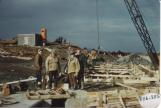28
CONCRETE INSPECTORS Constant monitoring of the concrete used to pour the canal walls was necessary. Young Robert A. Fox of Port Hastings worked for O.J. McCulloch Engineers Ltd. first as a surveying assistant and later as an assistant concrete inspector. He explains the process of quality control for the concrete."I used to go get samples [of concrete] from each pour that we were [doing]. We usually took a couple of buckets at two different times out of each pour and we used to make cylinders out of that. Then we kept them in a tank in the lab - for seven and 28 days and we would test them under an hydraulic press. That would give us the strength of the concrete. We used to check the concrete too before we made the cylinders, for moisture and slump."
29
Men pushing concrete bucket in place and one of the sets of forms at the bottom of the Canso Canal.13 May 1954
Canso Canal work site

30
FATAL ACCIDENT ON JOB - There were many jobs created during the construction of the Canso Causeway and Canal. Men came from the four counties on both sides of the Strait of Canso to work. Unfortunately, there were two fatalities during construction- one on the causeway construction site and Joseph Ryan from Antigonish County on his first day at work at the Canal site in June 1954.32
RESIDENT ENGINEERS OFFICEHarry MacKenzie worked for O.J. McCulloch, the consulting engineer. As the resident engineer, he monitored both projects from his office on the Cape Breton side. In an interview with Ron Caplan of Cape Breton's Magazine, MacKenzie admitted that while the causeway was the big project, it was a relatively easy one compared to engineering the lock."
"The Causeway wasn't such a whale of an engineering job... they would blast and then the next step of the job was to load that, lug it out to the Causeway. (Interviewer: Is that the building of the Causeway? You blasted the face off a mountain; you picked the rock up and put it on a truck; men drove to the water's edge?...) And dumped it. (And that was it?) That was it. That was all. The engineering part of it was the lock."
34
Canal site construction showing the Causeway approaching from mainland Nova ScotiaSeptember, 1954
Canso Canal work site

35
The Canso Causeway and Canal were constructed from 1952 to 1955 under a tri-party agreement between the federal Department of Transport, Nova Scotia Department of Highways and the Canadian National Railway. Funding was provided by the Department of Transport under this agreement to provide a fixed link between mainland Nova Scotia and Cape Breton Island to replace a marine ferry crossing between the villages of Mulgrave and Port Hawkesbury and Mulgrave and Point Tupper.37
"2,250 feet of cellular cofferdam and straight wall piling was used in excavation and construction of the Canso Canal and Locks. Because the land through which the canal cuts was not wide enough, the cellular cofferdam and straight wall pilings were put up and the space between them filled with earth and stone, excavated from the canal. 213,000 cubic yards of stone had to be dredged before the approaches were opened up." (Road to the Isle:The World's Deepest Causeway by L.J. Doucet).40
RESIDENT ENGINEER AND BOSS - Harry MacKenzie, resident engineer for the construction of the Canso causeway and Canal, looks on as his boss, O.J. McCulloch, peers across at the huge piles of sand and gravel stockpiled on the Canso Canal construction site at Balhache Point,Port Hastings, Cape Breton Island.Site preparation for the Causeway construction had begun in July 1952 and for the Canal site in April 1953.





